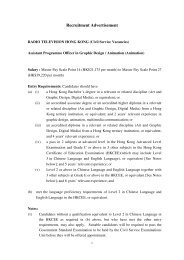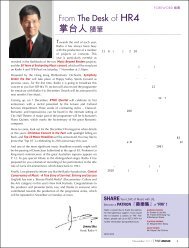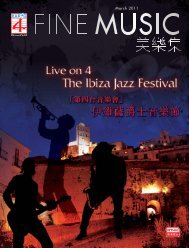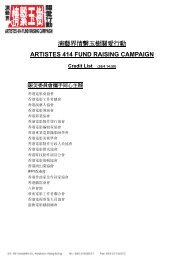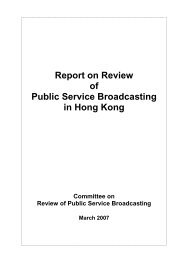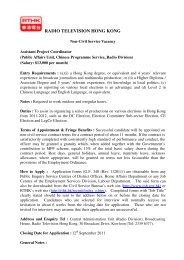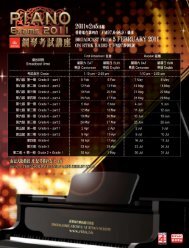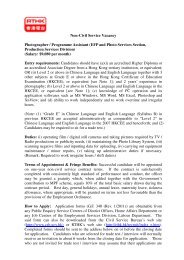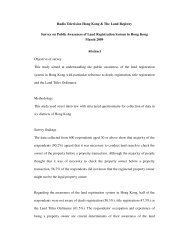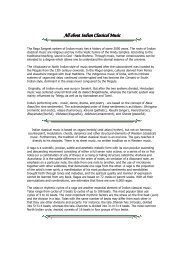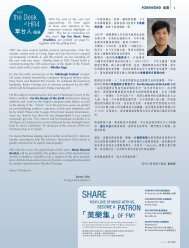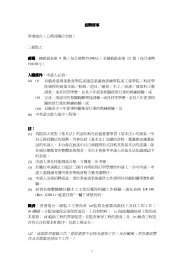ISDB-T(SB)
ISDB-T(SB)
ISDB-T(SB)
You also want an ePaper? Increase the reach of your titles
YUMPU automatically turns print PDFs into web optimized ePapers that Google loves.
Overview<br />
<strong>ISDB</strong>-T for sound broadcasting<br />
Terrestrial Digital Radio in Japan<br />
Shunji NAKAHARA<br />
NHK (Japan Broadcasting Corporation)<br />
2003/11/04 1<br />
Contents<br />
Features of <strong>ISDB</strong>-T <strong>SB</strong> system<br />
Current status of digital radio in Japan<br />
Examples of services<br />
Conclusion<br />
2003/11/04 2
Features of <strong>ISDB</strong>-T <strong>SB</strong> system<br />
Current status of digital radio in Japan<br />
Examples of services<br />
Conclusion<br />
2003/11/04 3<br />
Features of <strong>ISDB</strong>-T <strong>SB</strong><br />
Expectation for <strong>ISDB</strong>-T <strong>SB</strong><br />
AM broadcasters:high quality audio services<br />
<br />
CD quality, stereo, no interference with by other AMs <br />
FM broadcasters multimedia services<br />
<br />
data services, still images,simple motion picture)<br />
Audiencestable reception even in mobile reception,<br />
high quality audio, useful information<br />
<br />
news, weather forecast, traffic information,<br />
<br />
information related to current program)<br />
mobile<br />
reception<br />
portable<br />
reception<br />
2003/11/04 4
Requirements for <strong>ISDB</strong>-T <strong>SB</strong><br />
enable mobile / potable reception like AM,FM<br />
transmit high quality audio equivalent to CD<br />
provide data services<br />
<br />
<br />
<br />
information related to current program<br />
independent information ex. latest news, weather forecast,<br />
traffic information, so on<br />
Electronic Program Guide<br />
save frequencies<br />
no guard bands between adjacent broadcasters who<br />
transmit at a same site<br />
simplify allotment of channels for <strong>ISDB</strong>-T <strong>SB</strong><br />
Single Frequency Networks<br />
Features of <strong>ISDB</strong>-T <strong>SB</strong><br />
2003/11/04 5<br />
Elemental technologies of <strong>ISDB</strong>-T <strong>SB</strong><br />
Features of <strong>ISDB</strong>-T <strong>SB</strong><br />
technologies to realize requirements<br />
enable mobile / potable reception<br />
OFDM modulation scheme<br />
transmit high quality audio<br />
MPEG-2 AAC (Advanced Audio Coding)<br />
provide data services<br />
MPEG-2 Systems provide multimedia broadcasting<br />
save frequencies<br />
SFN<br />
band-segmented OFDM<br />
2003/11/04 6
Modulated OFDM signals<br />
(Time and Frequency domains)<br />
Guard intervals<br />
I F F T<br />
Symbols<br />
F F T<br />
ts<br />
tg<br />
Time<br />
1/ ts<br />
<br />
<br />
Frequency<br />
2003/11/04 7<br />
Transmission parameters of<br />
OFDM segment<br />
<strong>ISDB</strong>-T Mode Mode 1 Mode 2 Mode 3<br />
Bandwidth<br />
430kHz<br />
Carrier spacing 3.968kHz 1.984kHz 0.992kHz<br />
Total number of carriers 108 216 432<br />
Carrier modulation<br />
QPSK, 16QAM, 64QAM, DQPSK (OFDM)<br />
Number of symbols<br />
per frame<br />
204<br />
Useful symbol duration 252 µs 504 µs 1.008 ms<br />
Guard Interval duration<br />
1/4, 1/8, 1/16, 1/32 of useful symbol duration<br />
Frame duration 53 - 64 ms 106 - 129 ms 212 - 257 ms<br />
Inner code Convolutional Code (1/2, 2/3, 3/4, 5/6, 7/8)<br />
Outer code RS (204,188)<br />
Interleaving<br />
frequency and time interleaving<br />
Length of time interleaving 0, 0.1, 0.2, 0.4, 0.8s<br />
Information rate<br />
280kbps - 1.8Mbps<br />
2003/11/04 8
Features of <strong>ISDB</strong>-T <strong>SB</strong> system<br />
Current status of digital radio in Japan<br />
Examples of services<br />
Conclusion<br />
2003/11/04 9<br />
Current status of digital radio in Japan<br />
<strong>ISDB</strong>-T <strong>SB</strong> commenced in Japan<br />
started in Oct. 10 2003<br />
services as an independent new medium<br />
Analog AM and FM are continued<br />
Frequency : 188-192MHz (VHF ch.7)<br />
Bit Rate : 330kbps (=1 Segment)<br />
High quality sound MPEG-2AAC 144Kbps = CD Quality)<br />
Radio broadcaster can send still images and motion pictures<br />
Receiver presents Electronic Program Guide<br />
2003/11/04 10
<strong>ISDB</strong>-T <strong>SB</strong> Receiver<br />
Current status of digital radio in Japan<br />
2003/11/04 11<br />
Features of <strong>ISDB</strong>-T <strong>SB</strong> system<br />
<strong>ISDB</strong>-T <strong>SB</strong> commenced in Japan<br />
Examples of services<br />
Conclusion<br />
2003/11/04 12
Examples of services on a program guide<br />
Time<br />
7<br />
8<br />
News Music<br />
Kanto<br />
Area News<br />
Audio<br />
Classic Music<br />
(High Quality Sound Program)<br />
Tokyo<br />
News<br />
144kbps<br />
Yokohama<br />
News<br />
Chiba<br />
News<br />
Program<br />
Related Data<br />
Text<br />
Title<br />
Player’s<br />
Info<br />
etc.<br />
Local<br />
Event<br />
Info<br />
etc.<br />
Image<br />
Portrait<br />
Of<br />
Conductor<br />
etc.<br />
Poster<br />
etc.<br />
Examples of services<br />
Independent<br />
Data<br />
Text &<br />
Image<br />
Anytime<br />
News<br />
Text &<br />
Image<br />
Traffic<br />
Info<br />
EPG<br />
9<br />
Education<br />
English<br />
Listening<br />
English<br />
Conversation<br />
Basic<br />
English<br />
Business<br />
English<br />
Germany<br />
Chinese<br />
Arabic French Spanish<br />
Italian Russian Hankul<br />
2003/11/04 13<br />
Curriculum<br />
Text<br />
Book<br />
Picture<br />
of<br />
Book<br />
36kbps 36kbps 36kbps 36kbps<br />
64kbps<br />
52kbps 70kbps<br />
Bit Rate<br />
Features of <strong>ISDB</strong>-T <strong>SB</strong> system<br />
<strong>ISDB</strong>-T <strong>SB</strong> commenced in Japan<br />
Examples of services<br />
Conclusion<br />
2003/11/04 14
Conclusion<br />
Features of <strong>ISDB</strong>-T <strong>SB</strong> system<br />
uses OFDM scheme and MPEG2 AAC<br />
provides high quality audio and data services<br />
<strong>ISDB</strong>-T <strong>SB</strong> commenced in Japan<br />
Examples of services<br />
more details of <strong>ISDB</strong>-T BS are introduced in<br />
next session<br />
business, receivers,frequencies, and coverage<br />
2003/11/04 15<br />
Thank you for your attention.<br />
2003/11/04 16
implementation issues<br />
<strong>ISDB</strong>-T for sound broadcasting<br />
Terrestrial Digital Radio in Japan<br />
Shunji NAKAHARA<br />
NHK (Japan Broadcasting Corporation)<br />
2003/11/04 17<br />
Contents<br />
“Analog to Digital” by <strong>ISDB</strong><br />
Frequencies for Digital Radio in Japan<br />
Features of <strong>ISDB</strong>-T <strong>SB</strong><br />
Actual services and receivers<br />
Structure of <strong>ISDB</strong>-T <strong>SB</strong> segments<br />
Digital radio project and broadcasters<br />
Conclusion<br />
2003/11/04 18
“Analog to Digital” by <strong>ISDB</strong><br />
Frequencies for Digital Radio in Japan<br />
Features of <strong>ISDB</strong>-T<strong>SB</strong><br />
Actual services and receivers<br />
Structure of <strong>ISDB</strong>-T<strong>SB</strong> segments<br />
Digital radio project and broadcasters<br />
Conclusion<br />
2003/11/04 19<br />
Analog Media<br />
Media<br />
AM<br />
Radio<br />
FM<br />
Radio<br />
Terrestrial<br />
TV<br />
Satellite<br />
Cable<br />
Service<br />
began<br />
1925<br />
1969<br />
1953<br />
1984<br />
1955<br />
Num of<br />
Stations<br />
47<br />
53<br />
127<br />
19<br />
669<br />
Num of<br />
Transmitters<br />
(satellites)<br />
621<br />
810<br />
15058<br />
5<br />
994<br />
“Analog to Digital” by <strong>ISDB</strong><br />
Freq.<br />
531-1602<br />
KHz<br />
76-90<br />
MHz<br />
90-770<br />
MHz<br />
11-12<br />
GHz<br />
90-770<br />
MHz<br />
(As of 2002)<br />
Rate of<br />
Penetration<br />
99.9%<br />
96.0%<br />
99.4%<br />
43.3%<br />
19.3%<br />
2003/11/04 20
Road Map to the Digital in Japan<br />
“Analog to Digital” by <strong>ISDB</strong><br />
Media<br />
AM Radio<br />
FM Radio<br />
Terrestrial<br />
TV<br />
Digital<br />
begins<br />
As a New<br />
Media<br />
2003.10<br />
2003.12<br />
Analog<br />
ends<br />
Remain<br />
2003.11<br />
Service<br />
Audio<br />
Text<br />
Still Images<br />
Motion Pictures<br />
Motion Pictures<br />
<strong>ISDB</strong><br />
<strong>ISDB</strong>-T <strong>SB</strong><br />
<strong>ISDB</strong>-T<br />
Satellite TV<br />
Cable TV<br />
2000.12<br />
2001<br />
2003.11<br />
Hi-Vision<br />
5.1 Surround<br />
Text<br />
Still Images<br />
<strong>ISDB</strong>-S<br />
<strong>ISDB</strong>-C<br />
2003/11/04 21<br />
“Analog to Digital” by <strong>ISDB</strong><br />
Frequencies for Digital Radio in Japan<br />
Features of <strong>ISDB</strong>-T<strong>SB</strong><br />
Actual services and receivers<br />
Structure of <strong>ISDB</strong>-T<strong>SB</strong> segments<br />
Digital radio project and broadcasters<br />
Conclusion<br />
2003/11/04 22
Frequencies for terrestrial broadcastings<br />
in Japan<br />
700<br />
<br />
Frequencies for Digital Radio in Japan<br />
Sites and numbers of existing<br />
Analog TV stations<br />
Digital Radio introduced in VHF<br />
Digital TV introduced in UHF<br />
red dots<br />
analog TV<br />
transmitters sites<br />
Number of stations<br />
600<br />
500<br />
400<br />
300<br />
200<br />
100<br />
0<br />
Existing Analog TV Stations<br />
Channelsapprox. 15,000<br />
<br />
Stations approx. 3,500<br />
10 20 30 40 50 60<br />
VHF<br />
channel number<br />
UHF<br />
2003/11/04 23<br />
Frequencies for terrestrial broadcastings<br />
in Japan<br />
Assignment from 2003 to the year 2011<br />
Frequencies for Digital Radio in Japan<br />
AM radio<br />
FM radio<br />
Analog television<br />
and Digital radio VHF<br />
Digital television<br />
and Analog television UHF<br />
531~1602kHz 76~90MHz 90~108MHz 170 ~ 222MHz 470MHz ~ 770MHz<br />
ch1 3 4 7<br />
ch13 62<br />
8 12<br />
188MHz<br />
188MHz<br />
channel 7<br />
192MHz<br />
194MHz<br />
198MHz<br />
channel 8 <br />
Frequencies<br />
for terrestrial digital radio<br />
2003/11/04 24
Frequencies for Digital Radio in Japan<br />
Frequencies for terrestrial broadcastings<br />
in Japan<br />
Assignment from 2003 to the year 2011<br />
AM radio<br />
FM radio<br />
Analog television<br />
and Digital radio VHF<br />
Digital television<br />
and Analog television UHF<br />
531~1602kHz 76~90MHz 90~108MHz 170 ~ 222MHz 470MHz ~ 770MHz<br />
ch1 3 4 7<br />
ch13 62<br />
8 12<br />
Assignment after the year 2011<br />
AM radio<br />
FM<br />
radio<br />
Digital radio<br />
/ (mobile communications)<br />
VHF<br />
Digital television<br />
UHF<br />
531~1602kHz 76~90MHz 90~108MHz 170 ~ 222MHz 470MHz ~ 710MHz<br />
ch1 3 4 7<br />
ch13 52<br />
2003/11/04 25<br />
8 12<br />
“Analog to Digital” by <strong>ISDB</strong><br />
Frequencies for Digital Radio in Japan<br />
Features of <strong>ISDB</strong>-T<strong>SB</strong><br />
Actual services and receivers<br />
Structure of <strong>ISDB</strong>-T<strong>SB</strong> segments<br />
Digital radio project and broadcasters<br />
Conclusion<br />
2003/11/04 26
Significant features of <strong>ISDB</strong>-T <strong>SB</strong> (1)<br />
<strong>ISDB</strong>-T <strong>SB</strong> is named digital system F<br />
in Recommendation ITU-R BS.1114-2<br />
Source coding<br />
MPEG-2 AAC (Advanced Audio Coding)<br />
international standard : ISO/IEC 13818-7<br />
AAC coding of 144kbps can bring High-quality and efficient<br />
sound broadcasting<br />
Multiplexing<br />
MPEG-2 Systems<br />
international standard : ISO/IEC 13818-1<br />
provide multimedia broadcasting<br />
<strong>ISDB</strong>-T <strong>SB</strong> has compatibility with many digital systems<br />
through MPEG-2 transport stream<br />
Transmission (next slide)<br />
2003/11/04 27<br />
Features of <strong>ISDB</strong>-T <strong>SB</strong><br />
Features of <strong>ISDB</strong>-T <strong>SB</strong><br />
Significant features of <strong>ISDB</strong>-T <strong>SB</strong> (2)<br />
Transmission scheme<br />
Common system both television and sound broadcasting<br />
rugged system which uses<br />
OFDM modulation scheme (band segmented OFDM)<br />
two-dimensional frequency-time interleaving<br />
Convolutional code + Reed-Solomon code<br />
realize high reliability to make Mobile and portable reception<br />
possible<br />
capable to transmit information bit rates of 330kbps per<br />
segment<br />
save frequencies because of SFN (Single Frequency<br />
Network) and a connected transmission scheme<br />
2003/11/04 28
Features of <strong>ISDB</strong>-T <strong>SB</strong><br />
Maximum speed depending on Mode<br />
Maximum speed (km/h)<br />
800<br />
600<br />
400<br />
200<br />
100<br />
Mode1<br />
(2k)<br />
Mode2<br />
(4k)<br />
VHF (200MHz)<br />
UHF (770MHz)<br />
Mode3<br />
(8k)<br />
The Number of carriers (FFT size)<br />
2003/11/04 29<br />
“Analog to Digital” by <strong>ISDB</strong><br />
Frequencies for Digital Radio in Japan<br />
Features of <strong>ISDB</strong>-T<strong>SB</strong><br />
Actual services and receivers<br />
Structure of <strong>ISDB</strong>-T<strong>SB</strong> segments<br />
Digital radio project and broadcasters<br />
Conclusion<br />
2003/11/04 30
Format of Digital Terrestrial Audio<br />
and Example of Services<br />
<br />
Audio and Data Broadcasting<br />
Examples of format<br />
Basic (<br />
1<br />
Segment)<br />
330 kbps<br />
High Quality Sound Data CTL<br />
Ex.1<br />
Stereo<br />
Text Image Signal<br />
144 kbps 100kbps<br />
Mono Mono Data CTL<br />
Ex.2 Audio Audio<br />
Text ImageMotion Pic Signal<br />
24kbps<br />
24kbps<br />
200 kbps<br />
Actual services and receivers<br />
Data Broadcasting at the other Media<br />
Satellite Digital Broadcasting 2000kbps fixed<br />
Terrestrial Analog TELETEXT 40kbps fixed<br />
character multiplex broadcast 7kbps mobile<br />
ISDN<br />
64kbps fixed<br />
IMT-2000<br />
384kbps mobile<br />
Extension<br />
( Segment)<br />
3<br />
Ex.3<br />
Ex.4<br />
High Quality Sound<br />
Stereo<br />
990 kbps<br />
Data<br />
Text ImageMotion Pictures,etc.<br />
144 kbps 700 kbps<br />
High Quality SoundHigh Quality Sound<br />
Stereo<br />
Stereo<br />
144 kbps 144 kbps<br />
Data<br />
Text ImageMotion Pictures, etc.<br />
550 kbps<br />
CTL<br />
Signal<br />
CTL<br />
Signal<br />
2003/11/04 31<br />
Examples of services on a program guide<br />
Time<br />
7<br />
8<br />
News Music<br />
Kanto<br />
Area News<br />
Audio<br />
Classic Music<br />
(High Quality Sound Program)<br />
Tokyo<br />
News<br />
144kbps<br />
Yokohama<br />
News<br />
Chiba<br />
News<br />
Program<br />
Related Data<br />
Text<br />
Title<br />
Player’s<br />
Info<br />
etc.<br />
Local<br />
Event<br />
Info<br />
etc.<br />
Actual services and receivers<br />
Image<br />
Portrait<br />
Of<br />
Conductor<br />
etc.<br />
Poster<br />
etc.<br />
Independent<br />
Data<br />
Text &<br />
Image<br />
Anytime<br />
News<br />
Text &<br />
Image<br />
Traffic<br />
Info<br />
EPG<br />
9<br />
Education<br />
English<br />
Listening<br />
English<br />
Conversation<br />
Basic<br />
English<br />
Business<br />
English<br />
Germany<br />
Chinese<br />
Arabic French Spanish<br />
Italian Russian Hankul<br />
2003/11/04 32<br />
Curriculum<br />
Text<br />
Book<br />
Picture<br />
of<br />
Book<br />
36kbps 36kbps 36kbps 36kbps<br />
64kbps<br />
52kbps 70kbps<br />
Bit Rate
Examples of services on a program guide<br />
Time<br />
Audio<br />
Actual services and receivers<br />
Program<br />
Related Data<br />
Independent<br />
Data<br />
Text&<br />
Image<br />
Text&<br />
Image<br />
10<br />
Music<br />
audio<br />
(L)<br />
audio<br />
(R)<br />
Foot ball game<br />
(Simple Motion Picture)<br />
Approx. 128kbps<br />
MPEG4?, H.264?<br />
Traffic<br />
Info<br />
EPG<br />
11<br />
Education<br />
English<br />
Listening<br />
English<br />
Conversation<br />
Basic<br />
English<br />
Business<br />
English<br />
Germany<br />
Chinese<br />
Arabic French Spanish<br />
Italian Russian Hankul<br />
Front<br />
Page<br />
Of<br />
Text<br />
Book?<br />
Curri-<br />
Culum<br />
<br />
Text<br />
Book<br />
Bit Rate<br />
2003/11/04 33<br />
Digital Radio Receiver (1)<br />
Actual services and receivers<br />
Still Image<br />
latest News<br />
(e.g. Station Logo)<br />
Segment Number<br />
Program<br />
Related<br />
Information<br />
2003/11/04 34
Digital Radio Receiver (2)<br />
Actual services and receivers<br />
Anytime News<br />
(Text and image)<br />
Traffic Information<br />
Anytime News<br />
(Voice)<br />
2003/11/04 35<br />
“Analog to Digital” by <strong>ISDB</strong><br />
Frequencies for Digital Radio in Japan<br />
Features of <strong>ISDB</strong>-T<strong>SB</strong><br />
Actual services and receivers<br />
Structure of <strong>ISDB</strong>-T<strong>SB</strong> segments<br />
Digital radio project and broadcasters<br />
Conclusion<br />
2003/11/04 36
Structure of <strong>ISDB</strong>-T <strong>SB</strong><br />
segments<br />
Segmented OFDM transmission<br />
OFDM-Segment<br />
OFDM spectrum<br />
Frequency<br />
2003/11/04 37<br />
Connected transmission<br />
Structure of <strong>ISDB</strong>-T <strong>SB</strong><br />
segments<br />
Connected transmission<br />
Synchronize transmission<br />
No guard-band<br />
Non-connected transmission<br />
Non-synchronize transmission<br />
Guard-band<br />
needed<br />
… … … …<br />
…<br />
…<br />
…<br />
…<br />
430kHz<br />
Multi-one-segment<br />
transmission<br />
430kHz<br />
1.3MHz<br />
430kHz<br />
430kHz<br />
1.3MHz<br />
2003/11/04 38
Connected transmission<br />
Structure of <strong>ISDB</strong>-T <strong>SB</strong><br />
segments<br />
connected segments between ch.7 and 8 at present<br />
one segment has a band width of 430 kHz<br />
#1<br />
#2 #3 #4 #5 #6 #7 #8<br />
one segment<br />
frequency<br />
4MHz<br />
connected segments in a TV channel after 2011<br />
#1<br />
#2 #3 #4 #5 #6 # #8<br />
#9 #10 #11 #12<br />
frequency<br />
6MHz<br />
band width for one TV channel<br />
2003/11/04 39<br />
“Analog to Digital” by <strong>ISDB</strong><br />
Frequencies for Digital Radio in Japan<br />
Features of <strong>ISDB</strong>-T<strong>SB</strong><br />
Actual services and receivers<br />
Structure of <strong>ISDB</strong>-T<strong>SB</strong> segments<br />
Digital radio project and broadcasters<br />
Conclusion<br />
2003/11/04 40
Digital radio project and broadcasters<br />
Digital radio project and broadcasters in<br />
Japan (1)<br />
Digital Radio Promotion Association (DRP) was organized<br />
as a consortium constructed by 32 broadcasters as below<br />
Tokyo metropolitan area<br />
SEG<br />
#1<br />
SEG<br />
#2<br />
SEG<br />
#3<br />
SEG<br />
#4<br />
existing AM, FM broadcasters<br />
SEG<br />
#5<br />
SEG<br />
#6,7,8 (use 3ses)<br />
NHK<br />
VICS<br />
OSAKA metropolitan area<br />
SEG<br />
#1<br />
NHK<br />
VICS<br />
FM <br />
TBS R&C <br />
BAY FM <br />
<br />
SEG<br />
#2<br />
M B S<br />
SEG<br />
#3<br />
A B C<br />
FM<br />
J-WAVE <br />
SONY<br />
<br />
SONY <br />
<br />
communicatio<br />
ns network<br />
SEG<br />
#4<br />
SEG<br />
#5<br />
SEG<br />
#6<br />
SEG<br />
#7<br />
SEG<br />
#8<br />
<br />
Fm osaka FM<br />
AM<br />
<br />
<br />
<br />
KBS<br />
2003/11/04 41<br />
<br />
<br />
<br />
<br />
Digital radio project and broadcasters<br />
Digital radio project and broadcasters in<br />
Japan (2)<br />
Each group of broadcasters send MPEG2 transport streams (TS) to DRP<br />
DRP as a consortium re-multiplexes TS and modulates to an OFDM signal<br />
The OFDM signal is connected by 8 or 12 segments, and transmitted<br />
Receivers then tune into a segment to enjoy the programs<br />
broadcasters A<br />
broadcasters B<br />
broadcasters C<br />
Digital Radio<br />
Transport streams Promotion<br />
for 1 or 3 segment(s) Association (DRP)<br />
Re-multiplexing<br />
OFDM<br />
Modulation<br />
transmit <strong>ISDB</strong>-T <strong>SB</strong><br />
signal<br />
A B C D<br />
Freq.<br />
connected<br />
8 segments(4MHz)<br />
or 12 segments(6MHz)<br />
2003/11/04 42
Digital radio project and broadcasters<br />
License for Digital Radio in Japan<br />
licensed party<br />
Digital Radio Promotion Association (DRP)<br />
Station<br />
Tokyo station<br />
Osaka station<br />
Start<br />
Center frequency<br />
October 10th 2003<br />
190.214286 MHz (in channel 7)<br />
transmit power<br />
Power/ segment<br />
transmit site<br />
800 W<br />
(100 W)<br />
Tokyo tower<br />
240 W<br />
(30 W)<br />
Mount ikoma<br />
Coverage are<br />
Tokyo metropolitan<br />
area<br />
Osaka metropolitan area<br />
2003/11/04 43<br />
Coverage<br />
Transmitting tower<br />
Tokyo Tower<br />
2003/11/04 44
Coverage<br />
Coverage over Tokyo metropolitan area<br />
Japan<br />
Island<br />
Tokyo<br />
Coverage for mobile reception<br />
:field strength of 57dBµV/m<br />
(16QAM,coding rate ½)<br />
Coverage for mobile reception<br />
:field strength of 51dBµV/m<br />
(QPSK,coding rate ½)<br />
50 km<br />
Coverage for mobile reception<br />
:field strength of 39dBµV/m<br />
(QPSK,coding rate ½)<br />
2003/11/04 45<br />
Coverage over Osaka metropolitan<br />
area<br />
Japan<br />
Island<br />
Coverage<br />
Osaka<br />
Coverage for mobile reception<br />
:field strength of 57dBµV/m<br />
(16QAM,coding rate ½)<br />
Coverage for mobile reception<br />
:field strength of 51dBµV/m<br />
(QPSK,coding rate ½)<br />
Coverage for mobile reception<br />
:field strength of 39dBµV/m<br />
(QPSK,coding rate ½)<br />
50 km<br />
2003/11/04 46
“Analog to Digital” by <strong>ISDB</strong><br />
Frequencies for Digital Radio in Japan<br />
Features of <strong>ISDB</strong>-T<strong>SB</strong><br />
Actual services and receivers<br />
Structure of <strong>ISDB</strong>-T<strong>SB</strong> segments<br />
Digital radio project and broadcasters<br />
Conclusion<br />
2003/11/04 47<br />
Conclusion<br />
Digital radio business in Japan<br />
DRP as a consortium started digital radio business<br />
Oct.10th this year<br />
Digital radio system<br />
use <strong>ISDB</strong>-T for sound broadcasting system<br />
provide high quality audio and data services<br />
2003/11/04 48
Thank you for your attention.<br />
2003/11/04 49



